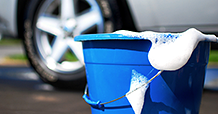Rinseless wash lets you drop the hose, save water

Sometimes using a hose and bucket just doesn’t make sense for washing a car.
"That’s especially true in drought-stricken areas where water is an expensive commodity. Apartment dwellers and urbanites also face challenges looking for an available faucet and appropriate location. "No wonder industry experts like Michael Stoops of Meguiar’s have switched to “rinseless” car wash.
Stoops lives in Southern California and wanted to save money on his monthly water bill. "Traditional car wash products require drivers to wash the vehicle and spay down the surface. The rinse stage “floods” away contaminants.
"In contrast, a rinseless car wash solution includes emulsifiers which lift contaminants off the surface. The solution encapsulates, or traps, dirt particles and allows them to be removed easily. “The chemistry is different from ordinary car wash soap,” said Stoops, who manages Meguiar’s on-line forum for customer inquiries.
Water savings are substantial.
“A rinseless car wash requires just two or three gallons of water,” Stoops said. “That compares to an estimated 30 to 90 gallons of water using traditional car wash methods.”
Rinseless car wash products offer a convenient alternative for city dwellers or apartments living.
“You just fill a bucket from the kitchen,” Stoops said. “You don’t need a hose and you can clean your car in a small area.”
Stoops admitted he is fastidious when it comes to his car. That became a problem when California imposed mandatory rationing. Like many water districts across the country, Southern California counties charge for metered usage rather than a flat rate. Allowing water to drain from a hose not only costs more but may run afoul of local rationing restrictions. Drought conditions have given rise to water police.
In California alone, 45 agencies now patrol for water wasters. Other states such as Texas and Colorado also have water patrols.
“We’ve got three cars at home and I haven’t pulled out a hose and bucket in three months,” Stoops said. “I even got my neighbor to switch over to rinseless car wash.”
Stoops had the following suggestions for drivers looking for ways to save money and time by using rinseless car wash products:
- Fill a small bucket with a few gallons of water and the rinseless car wash fluid. Some products include a synthetic wax to add shine.
- Use terrycloth or microfiber towels. Stoops recommended six or seven towels for cleaning and buffing. He does not recommend using a sponge because it clings to particles that may scratch the surface. “Using rinseless car wash properly is about towel management,” Stoops said.
- Fold the towel into quarters and drench it in the solution. Stoops suggested cleaning a two to three foot section at a time. “Don’t put the towel back into the bucket,” Stoops said. “Flip it over and use the other section.
- Clean with a fresh side of the towel for every section.” Immediately buff the section you have cleaned. Use a clean, dry towel rather than the same one used for washing.
- Clean wheels last since they typically are the dirtiest section of the vehicle. Wheel grime can soil towels in a hurry.
- Apply a coat of traditional wax. Stoops recommends waxing a vehicle every three months to add a layer of protection against environmental contaminants such as smog, road grime and bird droppings.
“You can clean your towels and wax applicators in the same wash load,” Stoops said. “Separate out the ones used for cleaning wheels. Brake dust is highly corrosive and you should keep a separate set of towels for wheels.”
Article by Jay Alling, editor of Sensible Driver. Write to jay@sensibledriver.com.
Copyright © 2024 by Sensible Driver. All rights reserved.
